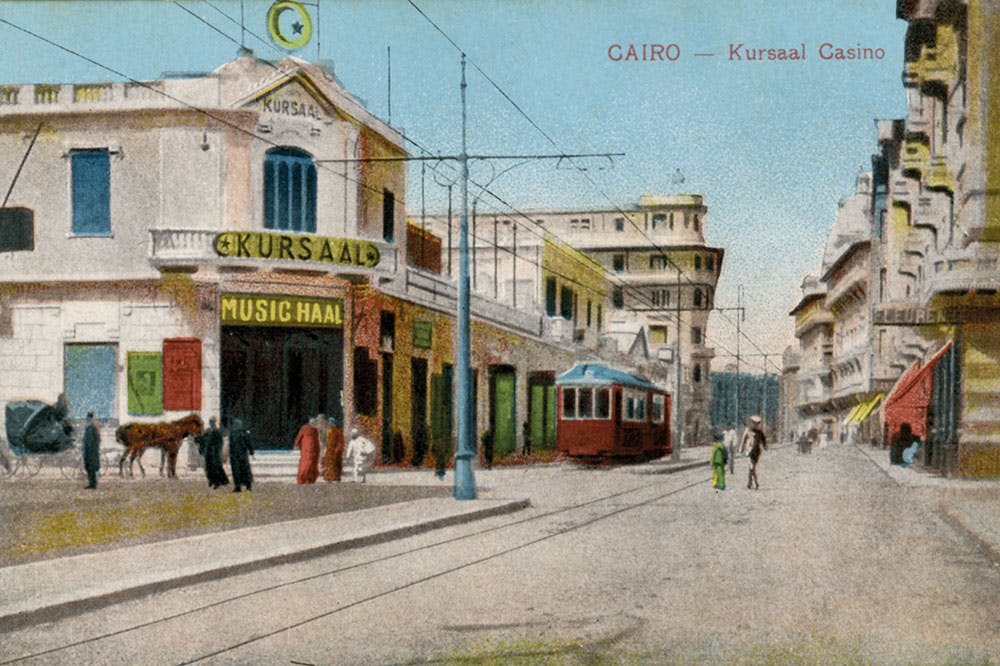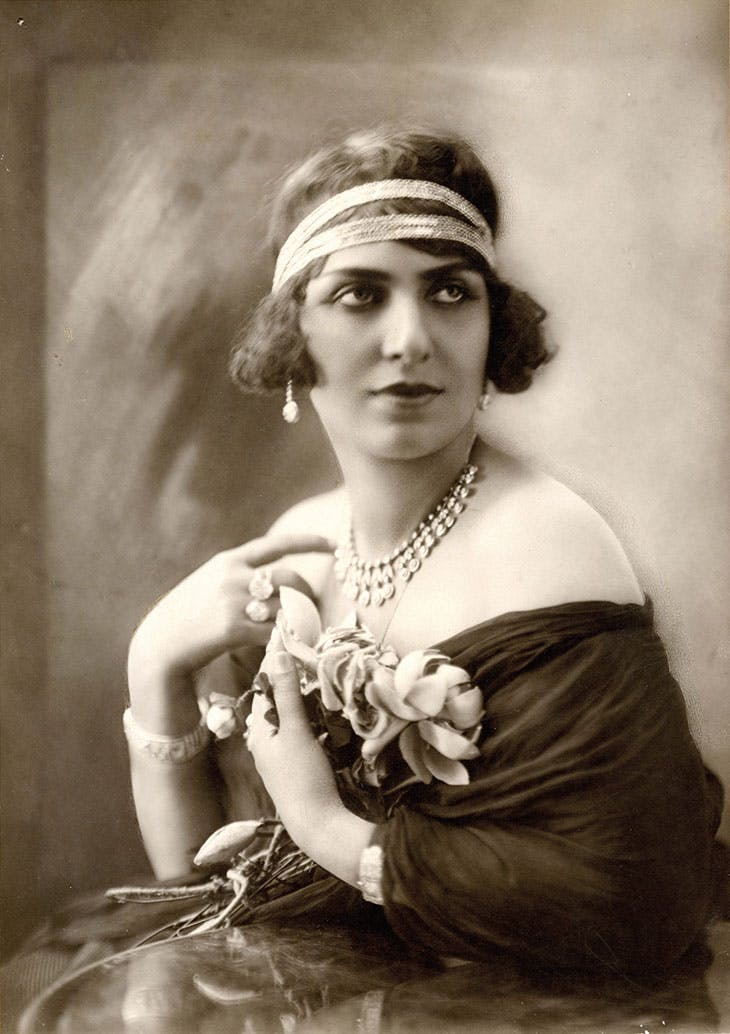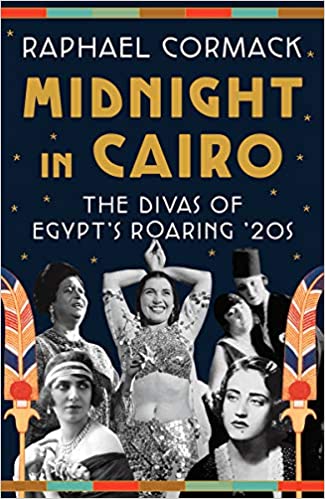From dust to glory – the divas of Egypt’s roaring 20s

Singing, dancing, drinking: back in the 1920s, Azbakeya – a district in downtown Cairo – was the centre of Egypt’s entertainment industry. In the introduction to your recent book "Midnight in Cairo – the Divas of Egypt’s roaring 20s" you even write that "in its heyday, the nightlife of Cairo could rival that in London, Paris or Berlin". What made Cairo and the Azbakeya district of the 1920s so special?
Raphael Cormack: The centre of Azbakeya and the Azbakeya Gardens were laid out during the first half of the 19th century under Mohammed Ali’s reign. But it was during the second half of the 19th century, that Ali’s grandson "Ismail the Magnificent" turned Azbakeya into Egypt’s modern nightlife and entertainment district, opening Egypt’s first opera house there in 1869, as well as other theatres and a circus. At the same time hotels, theatres, and dancehalls sprung up. By the 1920s, Cairo was a boom town, full of new investment, new development and one of the most cosmopolitan places in the world. You could almost call it "the Dubai of the 20s". This was one of the great cities of the world. But places like Cairo are not often written into the history of the 1920s. This book is an attempt to correct that.
What traces of the period can travellers and locals discover, when walking the streets of Azbakeya?
Cormack: The opera house famously burned down in 1971 and has been replaced by a big carpark. But if you walk around Azbakeya today, you will find many traces and the shells of former buildings. For example, an old door from one of the theatres is now being used as the entrance to a post office and the old Alhambra Casino, once run by artist Naima al-Misriyya is now a shop selling car parts. The old Egyptian Theatre on Abd al-Aziz Street has become a cinema, while its shell is now used as storage for many of the shops around.

If you walk along Emad al-Din Street, which in the 1920s was the main centre of action, you will still find several old theatres and cinemas from different time periods. One of them is the Naguib al-Rihani Theatre, formerly the Ramses Theatre, where Youssef Wahbi and his troupe used to play in the 20s and 30s. Many of these places are horribly run down. But in 2018, Cairo’s best modern art house cinema – Zawya – did relocate to one of the old cinemas on Emad Al-Din Street.
"Midnight in Cairo" tells the history of Azbakeya through the stories of seven women. One of them is singer and actress Mounira al-Mahdiyya. Compared to the other women in the book, her life fills significantly more pages. What was it about the "Queen of the Tarab" – as she was dubbed by the press at the time – that caught your attention?
Cormack: I am interested in the way she constructed her celebrity persona. She always made sure she was in the headlines, making statements that pushed the boundaries of taste at the time and throwing legendary wild parties at her houseboat.
One story that is not in the book, but which sums up Mounira’s public image happened at celebrations for the anniversary of King Fouad’s coronation in 1925. A big party was held in the Egyptian town of Mansoura and a lot of famous singers came to the town to put on shows, including Umm Kulthum and Mounira al-Mahdiyya. The Al-Ahram newspaper published an article afterwards, entitled "Umm Kulthum’s victory", which said that she was the best singer in town that night.

Soon after, someone wrote a response in Mounira’s defence: "I was very surprised to read that false headline". The letter writer went on to say that Mounira was the clear winner. Although all the other singers had stopped at midnight, her stage was packed until 2 am. Then, to stop so much commotion on the street, she moved into the main theatre in town and kept performing until 4 am.
Apart from her boldness, what makes Mounira al-Mahdiyya interesting from an artistic point of view?
Cormack: Mounira al-Mahdiyya left a huge mark on the period as a singer, an actress and a performer. She also represents the bridge between two worlds of Egyptian entertainment: she began her career prior to the First World War in old-style musical halls and later became the leader of her own theatre troupe, reputedly becoming the first Egyptian Muslim woman to act on stage. She moved into this new world of cabaret on Emad al-Din Street after WWI. Both the war and the 1919 revolution against the British occupation represented a huge turning point in Egyptian culture, with this sense of moving things forward. Mounira al-Mahdiyya was right at the centre of this development, managing to be incredibly successful in many different parts of the entertainment industry.
What kind of material did you gather to relate the stories of the women featured in "Midnight in Cairo"?
Cormack: The main sources to reveal what was going on in the lives of these women were the contemporary press and the memoirs most of them wrote. The book features autobiographical writing by all of them. Those who didn't actually publish their memoirs often left behind short newspaper articles.

I had the most fun discovering all the old showbiz magazines from the 1920s, which proved quite gossipy and full of good stories. The best collection of these is to be found at the National Library of Egypt. The American University of Beirut also has an amazing collection of material. I supplemented these findings with material scattered around the U.S. and the UK, and with online source material.
You write that "the history of Azbakeya is also the history of modern Egypt" and point to developments taking place in the country, such as the emergence of the early Egyptian feminist movement. Hoda Shaarawi – one of its prominent leaders – is portrayed in a rather negative light in your book, at least with regards to the singer and actress Fatima Sirri, who was romantically involved with Shaarawi’s son Mohammed.
Cormack: Having been in a relationship for some time, Fatima Sirri and Mohammed Shaarawi entered an urfi marriage in 1924 – a privately drafted arrangement signed before witnesses, but not registered with the state. Shaarawi also kept the marriage a secret from his family and friends. Not long afterwards Fatima gave birth to their daughter Leyla, upon which Mohammed promptly left her. Fatima Sirri decided to go to court and sued him successfully for support.
From 1926 -27, while the trial was ongoing, Fatima Sirri published her accounts of events in Al-Masrah and claimed that Hoda Sharaawi did not want her son to be with a singer and may have tried to break up the couple. My intention was not to disparage the achievements of the big-name feminists of the 1920s like Hoda Shaarawi; their achievements are admirable and undeniable.
However, I did want this book to show that there was another side to feminism in Egypt at the time too, one that is often ignored, because the world it inhabited was either perceived as lower class or debauched.
Fatima Sirri’s story suggests that – behind the glitzy facade – the lives of the women in Egypt’s entertainment industry of the 20s and 30s were not always that glamorous. What did you encounter when researching the women of Azbakeya?
Cormack: On the one hand, writing about these women means celebrating what they accomplished. But it is also important to show that Azbakeya was far from a feminist paradise. Cases of sexual violence, abuse and exploitation also from part of that history. Even the most famous women had to cope with all of that. Those women whose stories are not recorded probably had it worse. One example is the dancer Imtithal Fawzi, who was trying to set up her own cabarets. She came up against a gang of men who tried to force her into paying protection money. When Fawzi refused, one of the gang members killed her in her own nightclub. The only reason we know what happened today is because this incident was so brutal it was recorded in the press. I am sure there were many more stories that went unrecorded.
What are some of the other traps you tried to avoid when writing about this specific period?
Cormack: The big trap when writing about the 20s and 30s in Egypt is that of nostalgia. People simply view this period of Egyptian culture through very rose-tinted spectacles – as an era of endless possibility. Yet it would be the nineteen-fifties before Egyptian women gained suffrage, and doubtless Egyptians as a whole had more rights in the 1950s than they did back in the Roaring Twenties. Another aspect that gets romanticised, especially by European writers, is the cosmopolitanism of this period, which is portrayed as something rather exclusive. I have tried to show that Cairo’s cosmopolitanism included Arabic-speaking Egyptians as much as anyone else – the Greeks, English, French and so on.

Umm Kulthum, whose breakthrough also came in 1920s Cairo, created an undeniable and international legacy that will likely last for at least another 100 years. Apart from her success, what is Azbakeya’s artistic legacy?
Cormack: There are so many strands of artistic production! Theatre, dance, singing and cinema – they are all connected, because many artists from that era were involved in different types of entertainment. It was a period that saw the foundations being laid for so much of contemporary Egyptian culture – and these women were at the heart of all of it. You cannot talk about the golden age of the Egyptian cinema during the 50s and 60s without referencing Aziza Amir, who starred in what is remembered as the first Egyptian movie – "Laila" – in 1927. And when it comes to theatre, Fatima Rushdi was one of the greatest troupe leaders of the 20s and 30s. She not only dominated Cairo’s theatre scene, but she also took her plays on tour throughout the Middle East and North Africa – despite the fact that these days people only tend to remember Youssef Wahbi. She and Bahiga Hafez were also pioneers of Egyptian cinema.
And then came the 2011 Revolution, which saw a lot of music from the 1920s resurfacing.
Cormack: There was a kind of what I would call "inclusive nationalism" – expressed through songs written by people like Sayed Darwish during and after the 1919 Revolution against the British occupation – that really resonated with people in 2011. In 2014, writer and theatre director Leila Soliman premiered a play called "Hawa el Horreya" , that is, 'whims of freedom', which drew clear parallels between 1919 and 2011. There is growing interest in the Egypt of the 1920s and 1930s because of the sense of possibility and progress that defined the era. "Midnight in Cairo" aims to show both the complexities of the period and the things that still make it so appealing today.
Interview conducted by Anna-Theresa Bachmann
© Qantara.de 2021
Raphael Cormack holds a PhD in Egyptian theatre from the University of Edinburgh and is currently a visiting researcher at Columbia University, New York. He is an award-winning editor and translator and has written on Arabic culture for the London Review of Books, Prospect and the TLS, among others. He is editor of "The Book of Cairo" and co-editor of "The Book of Khartoum".